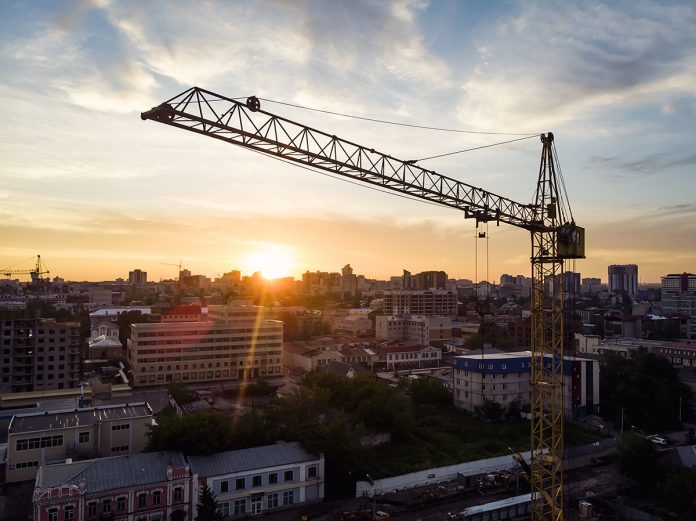What is Construction Management? Construction Management Definition & Meaning.
- Construction management: statistics
- Features and functions of construction management
- Construction types
- Construction project stages
- Potential issues during and after a construction project
- Construction management software
- Resolving disputes and documenting activity in a construction project
- General contractors and construction managers
- Becoming a construction manager
- Conclusion

Construction management is a term that has progressively gained popularity in the construction industry. But what is construction management in the first place? In general terms, construction management is a service that oversees and manages construction projects from beginning to end (planning, design, and construction phases) by utilizing various project management methods and techniques.
The fact that there are not that many large projects that can be completed within their original time frame is well-known in the construction industry, with many projects closing about 20% past the original deadline and running way over the original budget estimates.
The general poor productivity of the construction industry as a whole leaves it “in the dust” when compared with how other sectors of the economy grow on a yearly basis. It is speculated that if the industry as a whole caught up with the growth rates of the other industries, it would bring an estimated $1.6 trillion of value, or 2% of the global economy’s growth, which is simply staggering.
Figuring out ways to make the industry as a whole is the main goal of a construction manager. There are several reasons why it is so popular nowadays that it was named the #1 construction-related job in 2020, according to the U.S. News & World Report.
Managing the three primary parameters of a project in question – quality, cost, and delivery time – is the primary goal of construction management as a process. Construction management as a whole is also compatible with several different preexisting project delivery systems, such as a design-build system.
Some of the more experienced construction managers are also hired to work at capital projects – massive and costly construction projects on an extraordinary scale, such as military infrastructure, commercial real estate, industrial facilities, transportational infrastructures, and more.
Construction management: statistics
Construction management as a whole can be described as a highly stressful profession with great growth potential. According to BLS, the average median pay of a construction manager in 2021 was:
- $47.55 in an hour;
- $98,890 in a year.
Information from the U.S. News & World Report also confirms this data, with the best-paid 25% of construction management earning a median salary of $128,860 in the year 2020. It can be considered one of the highest-earning job positions in the construction industry, getting a higher median salary than carpenters ($49,520 in 2020), plumbers ($56,330 in 2020), and even architects ($82,320 in 2020).
Education-related prerequisites are rather high for the profession – at least a B.A. in either Construction Science, Construction Management, or a field closely related to those two. It is also fairly common for the job offer to have a demand for work experience in the field.
It is possible to obtain additional proof of your experience in the field by going through the official construction management certification process – the Certified Construction Management program (CCM). CMAA invented this process – the Construction Management Association of America, a well-known professional association in the construction management field with over 14,000 members.
There are also quite a lot of soft skills that are required from a construction manager, such as decision-making, time management, budgeting, leadership, collaboration, public speaking, innovation, and customer service, among others.
Features and functions of construction management
As the construction management definition suggests, the main cornerstone of it all is a person who holds a construction manager’s position. A construction manager’s list of responsibilities includes time management, quality management, cost management, decision making, public safety, human resources management, work drawings management, and more.
As for the process itself, it’s possible to figure out four primary functions of construction management as a whole, including:
- Increasing resource efficiency via effective materials, equipment, and labor procurement.
- Setting up various operations throughout the entire construction process and implementing them at various stages of a construction project – from pre-design to post-construction maintenance.
- Figuring out construction management plans and objectives of a construction project in question, including a project’s scope, schedule, budget, and a list of participants.
- Resolving potential conflicts by developing various measures to prevent or circumvent any problems.
Construction types
There are seven main types of construction that can take advantage of construction management as a process: industrial, residential, commercial, institutional, agricultural, environmental, and heavy civil.
Industrial construction is represented by manufacturing plants, power plants, oil refineries, and other buildings and/or items used to produce or store products. Residential construction includes various houses, apartments, low-rise housing, small offices, and so on.
Trade, private commerce, and services are the main targets of commercial construction, represented by offices, shopping centers, casinos, banks, golf courses, and such. On the other hand, the institutional construction category represents the needs of various public organizations (including the government itself). It covers multiple building types, from police stations and museums to hospitals and governmental buildings.
Anything connected with agricultural purposes gos to the agricultural construction category, including storage silos, barns, animal sheds, specialized fencing, etc. Environmental and heavy civil categories have been treated as the same for a while. Still, they now are separate categories – with heavy civil construction represented by various transportational infrastructure (roads, tunnels, airports, etc.), and environmental construction covering water treatment plans, storm sewers, waste management facilities, and some other specific examples.
Construction project stages
While many different nuances might change this order, it’s possible to figure out four main stages of a regular construction project – design, pre-construction, procurement, and construction. The construction management department monitors each of these stages, which makes necessary adjustments and monitors the overall efficiency.
The design stage focuses mainly on ensuring that the project’s design meets all of the requirements and regulations. This stage also covers the bidding process. This is where contract documents are drafted, design development is performed, and designs, in general, are finalized before the next step begins.
The next step of the process is the pre-construction. Here the project team is created, outfitted with a project manager, a field engineer, a contract administrator, and other specialists. A thorough construction site investigation is also performed on this project stage.
Another important stage is procurement, which focuses on getting the necessary materials, equipment, and labor, via a general contractor or subcontractors. Subcontractors specialize in one specific type of construction material or work, including concrete, glass, etc.
Construction is the final part of this process, covering the actual construction process, the pre-construction meeting, the set-up before the process starts, and progress payments for the job. The most common use case is for payments to be made on a monthly basis.
Potential issues during and after a construction project
Dust and mud are two significant issues that construction projects have to compensate for. Dust is created by construction vehicles driving around the construction site and/or moving large amounts of earth. A lot of mud is created by attempting to reduce the amount of dust by using a water truck that sprays water over the site, producing an entirely different batch of problems. The problem of dirty roads can also be compensated for by using a street sweeper on the streets surrounding the construction site.
Other potential problems are mostly tied with environmental effects, such as:
- Wetlands – Both erosion and water flow are not supposed to be affected by the construction process, meaning that any liquid spills in the process must be strictly monitored.
- Vegetation – Some specific protected trees or other vegetation types can be found on the construction site, requiring a fence or a security tape to mark the importance of this vegetation assuring that no harm is done to it.
- Water pollution – Large amounts of soil that are extracted from their original location might cause several varying environmental problems in the future; a good example of such a problem is runoff, which can potentially pollute lakes, rivers, and other water bodies with harmful pollutants.
- Various artifacts – Both historical and cultural artifacts located during the construction process should result in the entire production shutting down until the artifact in question is examined and removed from the area in its entirety.
- Endangered species – A construction site must be shut down for an unspecified amount of time if an endangered species has been found on that site; the shutdown lasts as long as it takes for local authorities to decide on the species in question.
Construction management software
While it is true that construction management as an industry brings insanely high value to the world economy, all the productivity issues are still keeping it from reaching its full potential. Many different elements of the construction industry changed as time passed. Computer screens replaced drawing boards as the main place that hosts project designs. Project drawings are also now kept in digital form more often than not and sent using emails or many collaboration platforms, such as Google Drive or Dropbox, instead of being sent using regular mail.
However, these advancements still cannot change the fact that the construction industry has a long way to go regarding full digitalization. This particular McKinsey Global Institute report makes it obvious that the construction industry is considered one of the slowest industries in “digitalization,” with hunting and agriculture being the only two examples that are even slower on this front.
The construction industry’s reliance on older and manual methods makes it more prone to mistakes that could have been prevented if the industry had been more digital in the first place, which makes the construction industry as a whole rather complicated to work in.
Resolving disputes and documenting activity in a construction project
Regular project meetings have to be a part of the project’s schedule, mainly discussing the progress of the entire project and any potential problems with it. A construction manager is a necessary participant in each of these meetings. Each discussion, as well as any changes or decisions that have been made during discussions, have to be properly documented.
There are three types of documents used to keep track of the daily changes of a specific project – daily field reports, logs, and diaries.
Daily field reports are your traditional formal way of recording activities on the construction site. Some of the parameters included in daily field reports are deliveries, activities, weather conditions, equipment used, visitors, and more.
Logs are there to keep track of all the routine, regular activities, including delivery logs, RFI logs, phone logs, etc.
Project diaries are supposed to represent daily routine work in the words of a project team member. It is expected of each team member to keep and write in such a diary regularly. These diaries can act as the means of solving disputes, and handwritten diary entries can be used in court as evidence.
Speaking of disputes, there are three main ways that the disputes can be resolved – mediation, mini-trial, and arbitration.
As the name suggests, mediation relies on a third party – a mediator – to resolve various disputes. The main goal of a mediator is to help conflicting parties reach an agreement of sorts. This way is the least time-consuming out of the three and does not involve any attorneys in the process.
Mini-trial is exactly what it implies – a miniature trial that is organized for the sole purpose of resolving a specific agreement. A mini-trial, by nature, is somewhat more time- and money-consuming if compared to mediation. It involves an attorney or advisor (on a paid basis) and usually takes place in an informal setting.
The original purpose of a mini-trial is the same as with mediation – to help with reaching an agreement between disputing parties. Still, it is important to mention that any arrangement that is reached with a mini-trial is not legally binding and can be easily broken.
Arbitration is the most time and effort-consuming method of solving a dispute. The entire dispute is reviewed in a setting similar to an official court – with attorneys, witnesses, arbitrators, and so on. Once all of the evidence is presented, the arbitrator is supposed to provide a binding final decision that cannot be broken by any of the disputing parties.
General contractors and construction managers
Since both the construction manager and general contractor must manage the project as a whole, it is easy to see where the confusion about these two terms comes from. However, what’s even more surprising is that these two jobs could not be more different, aside from a similar general explanation.
For example, a general contractor is chosen via the bidding process and only becomes involved in the project at its construction stage. In contrast, the project owners hire a construction manager during the earliest stages of the project’s creation – either pre-construction or planning. A construction manager’s knowledge is often used during the hiring process for other important posts in that same project, including architects, designers, and even general contractors.
There is also a massive difference between the two regarding their organizational structure. A general contractor is a business entity in itself, with its own set of office employees and its field of work. A general contractor often has a network of business partners that it hires to work on projects – vendors, subcontractors, and so on.
On the other hand, a construction manager serves the role of a consultant more than anything – be it a single construction manager or a team of managers. A construction manager is in no way involved in the construction process physically – their main task is to provide estimates, manage projects, serve as accountants, and so on. A construction manager can be responsible for tasks that can appear before the project is set in motion, during the project’s creation process, and some tasks that may appear after the project is already completed.
There are many other examples of how different general contractors and construction managers are, and these are just a few of the many differences on the list. It would also be fair to mention that, while it is true that construction management jobs typically have a higher salary than that of a general contractor, construction managers are also held to much higher standards in both experience and education when applying for the job, so the salary increase is only logical from this perspective.
Becoming a construction manager
The process of becoming a construction manager is not an easy one, and it involves both dedication and perseverance. First of all, education is paramount – while a bachelor’s degree is not the only option to obtain the necessary knowledge for the job, it is still one of the easier ways to get it. Getting a bachelor’s degree in one of the construction management-related specialties is a fairly popular field of education, too, so you may have to expect competition even before you get in.
Many universities in the world offer bachelor’s degree programs in the necessary fields – with courses on construction methods, building standards, project control, design, contract administration, and more. Suppose you want to start with small-scale projects. In that case, you can also try and get an associate’s degree, which is faster (only 2 years) but may not get you all of the information and experience necessary to manage bigger projects from the get-go.
For example, Salt Lake Community College offers a Construction Management Program, as well as several other programs in the field. At the same time, the University of Washington has its 9-month-long online program that gives you a construction management certificate. We can also mention Arizona State University and its online Master of Science in Construction Management and Technology degree, which is just one of many examples.
Of course, theoretical experience is only a part of the process. Practical experience in managing construction processes is also necessary, be it via training under an experienced construction manager or via one of the industries close to the construction management field, such as masonry or carpentry.
Certification of your skills may also be necessary for your future job, which is where the aforementioned CMAA comes in with its Certified Construction Manager (CCM) designation. This kind of certification requires a technical exam to be completed, as well as proof of your existing experience in the field.
Conclusion
Construction management is a sophisticated process that deals with the entirety of the construction process, primarily focusing on effective management. The nature of construction management as a whole remains the same, even though there are many different types of construction, each with its list of nuances and shortcomings.



